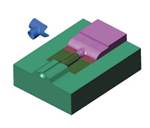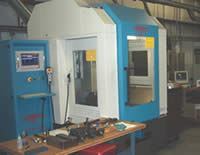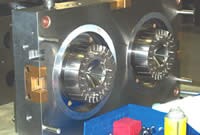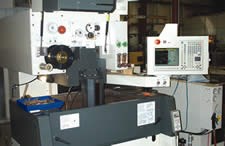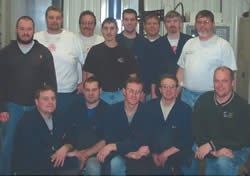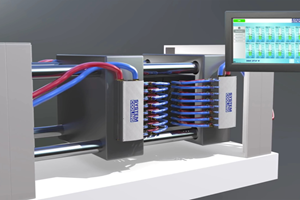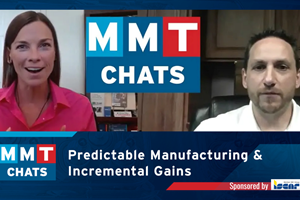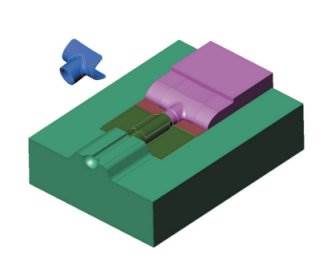M&M Tool and Mold: Formula for Success-Specialization, Automation And Customer Service
The third times a charm for this specialty mold shop that yields complex molds in tight leadtimes as it snags MoldMaking Technology's 2005 Leadtime Leader: Small Shop award three years running.
Ten years ago, M&M Tool and Mold, Inc. (Green Bay, WI) began as a two-man operation specializing in complex molds built with side actions, lifters, or other complicated action necessary to mold a part in short leadtimes—and in no time at all found its niche and began to thrive in an uncertain economy. The company's ability to survive—and prosper—has not only resulted in a 46.5 percent sales growth over the past three years as well as $4 million in sales last year, it also has won M&M a Leadtime Leader award three years in a row.
Twenty-three employees keep two facilities running with an average leadtime of five to six weeks—quite an accomplishment when building intricate, difficult-to-tool, plastic injection molds for the medical, automotive, consumer products, electric hand tools and paper industries. Co-owners Marty Ciriacks and Mike Richards' simple formula for satisfied customers: specialization, automation and customer service.
Over the past year, M&M has added a second shift. "Our workload and delivery schedule—along with our incredible growth spurt necessitated this," Ciriacks explains. "It is going better than we ever thought it could. We also have a new operations manager that controls the work flow through the shop. He has mold design knowledge and a significant amount of experience in how molds are built, which is instrumental in handling a significantly larger workload than we have ever been able to manage in the past. He is able to juggle many jobs concurrently with great success."
Specialization
Back in January of 1995, Ciriacks and Richard set up operations in a 750 square-foot garage with a mill, an EDM and a grinder. They both began their moldmaking journeys in 1983, and after serving apprenticeships together at the same shop, they decided to make a go of it on their own. After one month, they caught their first big break. "We were working with a company owner—who like us—struck out on his own," Richard explains. "He saw a lot of himself in us, so he gave us the project based on our character."
The project—a three-mold package—afforded the duo the opportunity to move into a 2,500 square-foot facility and hire an employee. Over the years, M&M slowly added more staff, and then moved into its current facility in 1997. Today, M&M occupies 12,500 square feet amongst two facilities. Its second facility—purchased in 2003 and located in Germantown, WI—complements the Green Bay shop. "We were lucky that this shop had the same CAD/CAM software and they were set up like us to do the same type/size work we do," Ciriacks comments. "It was an asset for us to be able to immediately service our existing customers in that area and, at the same time, present us with opportunities at other companies in the same area who—in the past—viewed proximity an issue."
Automation
Automated equipment fills M&M's shop floor (see Get More Info Above). According to Richard, there is automation in the changing of electrodes to the machine through the use of a 114-position robotic electrode loader. "Our future plans include a robotic mold insert changer for our high-speed, hard milling machines," Richard notes. "Although we seldom put a timetable on any major purchases because we feel it takes away from the big picture of building molds and growing the business, we are constantly doing research on the latest technology to make sure we are up-to-date with our equipment and not losing a competitive edge through outdated processes."
Customer Service
Ciriacks and Richards credit their employees' unwavering dedication and positive attitudes to M&M's continued success. "We continue to treat our employees as our most important asset," Ciriacks emphasizes. "We pay them well, have a nice fringe benefit package with profit sharing, and treat them how we would have liked to be treated when we were employees. We run our business as though we had 5,000 employees. Our 23 employees are our most important asset, even if it is only 23."
M&M's staff thrives under the duo's leadership. According to Ciriacks, several employees got together and developed some tricks to cut mold build times which he and Richard implemented throughout the shop. "I can't say enough how great our employees are and how well they work together to facilitate workflow through a method of in-process management that Mike and I have developed through the years," he enthuses. "We have people in place to deal with any level of a purchasing team—from engineers and project managers to business managers and professional buyers. Our staff provides a comfort level with the ability to react immediately and assure our customer of a project's well-being." Again, the company's operations manager plays a vital role in this process as the point of contact with customers and engineers at the beginning of a job and throughout the build process.
To additionally maintain quick leadtimes, designers and programmers work concurrently—often programming on jobs in their earliest stages of design with EdgeCAM software. Steel is cut before the complete design hits the floor and most portions of the mold design process are kept in-house to save time. Outsourcing mold bases is the company's sole exception. "We use Precision Mold Base Corporation in Tempe, AZ to ship us completed mold bases in three weeks," Richards notes. "That can't be beat. Otherwise, in the case of molds, quicker isn't better if the work isn't correct. We feel that there are few shops that can compete with us on quality in a timely manner when it comes to the critical part of the molds—the cavities and cores."
Looking Ahead
In an industry where change is constant, M&M prides itself on maintaining a consistent on-time delivery schedule coupled with an unwavering commitment to meeting its customers' needs. And, they are open to new ideas to further grow the company from customers, employees and peer groups. "We have partnered with a few mold builders overseas and can offer our customers both a low price tool with our backing, or our standard high quality mold in abbreviated time frames," Richard states. "We have become a one-stop shop for many different needs and applications. With the ability to sell low price tools alongside high quality tools, the customer knows they can make one call and get anything they want. We no longer get passed over when a customer knows the budget is tight. Whether it is a super high production part with multiple cavities or a market-entry, short-life tool, we can build it or source it for them."
In a nutshell, M&M has grown from 750 square feet to 12,500 square feet in two facilities over the course of a decade by simply concentrating on building the best mold possible in the shortest amount of time. "We don't see it wise or profitable to keep one eye on the competition," Ciriacks says. "It takes away from our goals internally. The way we gauge how we are doing is to look at the sales, then look at the bottom line. If Mike and I, our employees and the bank are pleased—we have done our job well."
Growth Spurt
M&M Tool and Mold—winner of three consecutive Leadtime Leader awards—sticks to a simple plan that allows them continued success: single-mindedly focusing on a niche while coming up with innovative ways to keep leadtime to an absolute minimum. "By standing by our niche, we have strengthened our relationship with current customers and have been able to expand not only our customer base, but also serve them all with additional capabilities, i.e. assisting with part design to make the parts more molding friendly and functionally practical," co-owner Marty Ciriacks explains. "This provides a higher quality part at a reduced cost because of improved moldability."
The year 2004 saw this small shop continue its successful climb up the moldmaking ladder. The shop grew 51 percent sales-wise, added four more employees, and plans on adding additional "specialty" people—like a designer and a cutter path programmer—early this year. M&M recently purchased some additional equipment for its second facility and is working to bring those employees up to speed with the Green Bay facility, Ciriacks notes.
Additionally, the company has established relationships with a number of new customers. "We have added three customers this year," Ciriacks states, "including a custom molder in southeast Wisconsin. We are really keeping our ear to the ground as we continue to expand our capabilities." Not too shabby for this small shop that has managed to grow from $300 thousand in sales that first year to more than $4 million a mere decade later.
On Winning
"When we were awarded the Leadtime Leader award the second time, we were very excited," M&M Tool and Mold co-owner Marty Ciriacks states. "Then, when we were informed that we had been chosen as the small shop category Leadtime Leader for a third straight year, we were completely ecstatic! We have worked very hard this last year and were very happy that someone noticed. The Leadtime Leader competition and the MoldMaking Expo bring together a group of people that are all interested in a relatively small sector of the economy, and that makes for lively and interesting conversation. The contacts and potential business that comes out of this multiday show are priceless. This third award is really something to be proud of."
![]()
Related Content
5 Ways to Make Your Tooling Assets Smarter
Global mold monitoring and asset management solutions can maximize productivity and efficiency.
Read MoreMMT Chats: Predictable Manufacturing and Incremental Gains Can Transform Moldmaking
MoldMaking Technology Editorial Director Christina Fuges catches up with the president of Eden Tool and Eden Manufacturing, Dave Tomic. We talk about predictable performance in moldmaking and the value of small incremental gains in an organization versus big change via disruptive technology. This episode is brought to you by ISCAR with New Ideas for Machining Intelligently.
Read MoreFive Strategies to Make Automation Affordable
Mold manufacturers can maintain their competitive edge by making smart capital investments in times of crisis.
Read MoreHow to Use Scientific Maintenance for More Accurate Mold and Part Troubleshooting
Discover how adopting scientific maintenance approaches helps improve mold lifespan, minimize failures, and optimize production outcomes.
Read MoreRead Next
Peterboro Tool: Niche Moldmaking Produces Profits
Producing wax injection molds has kept this moldmaker in the black for more than 30 years - and has earned it an Honorable Mention in MoldMaking Technology magazine's Leadtime Leader competition.
Read MoreHow to Use Strategic Planning Tools, Data to Manage the Human Side of Business
Q&A with Marion Wells, MMT EAB member and founder of Human Asset Management.
Read MoreHow to Use Continuing Education to Remain Competitive in Moldmaking
Continued training helps moldmakers make tooling decisions and properly use the latest cutting tool to efficiently machine high-quality molds.
Read More
